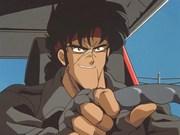The appeal and reviews of "Samurai Giants": An anime experience not to be missed

Samurai Giants - Samurai Giants - Appeal and Evaluation■ Public Mediatheater ■ Original Mediacomics ■ Release dateDecember 20, 1973 - January 1, 0000 ■Distribution companyToho ■ Eirin Number23681 ■Frequencies24 min ■ Number of EpisodesEpisode 1 ■Original StoryIkki Kajiwara and Kou Inoue ■Works©Kazuo Kajiwara and Ko Inoue/TMS ■ StoryManager Kawakami of the Yomiuri Giants, a professional baseball team that has won eight consecutive championships. However, he is keenly aware that the Giants need a samurai. The manager visits Kochi in search of the ideal player and learns of a pitcher named Banba Banba. However, although Banba Banba is a skilled pitcher, he has an overly bold personality and declares that his goal is to "defeat the Giants." ■ExplanationThis is a theatrical version based on the first episode of the TV anime "Samurai Giants." It was shown at the "Toho Champion Festival," and other films shown at the same time included "King Kong Strikes Back" (rerun), "Ultraman Taro," "Mountain Mouse Rocky Chuck," "Aim for the Ace!", and "Science Ninja Team Gatchaman." ■Cast・Banba Ban/Takayoshi Toyama/Tarohei Yawata/Rokuro Naya/Rika Minami/Reiko Muto/Yuki Banba/Rihoko Yoshida/Hikari Mayuzuki/Makio Inoue/Mansaku Ohou/Nishio Nori/Tetsuharu Kawakami/Shoichi Nishida/Shigeo Nagashima/Shunji Yamada/Sadaharu Oh/Tatsuyuki Ishimori ■ Main staff・Director and production: Tadao Nagahama ・Screenplay: Seiji Matsuoka ・Chief animation director: Yasuo Otsuka ・Art: Shichiro Kobayashi ・Original story: Ikki Kajiwara, Ko Inoue ・Planning: Juichi Sano ■ Main Characters Banba Banba is a pitcher from Tosa, Kochi Prefecture. He throws an incredibly fastball, but without control, and he overwhelms batters in many ways. He can get out of control, but... ■ Related works・Simultaneous screening of "Toho Champion Festival" "King Kong Strikes Back" Samurai Giants - Samurai Giants - Appeal and EvaluationSamurai Giants is a 1973 animated feature film that tells the story of the professional baseball team, the Yomiuri Giants. The film is based on the original manga by Ikki Kajiwara and Kou Inoue, and was adapted from the first episode of the TV anime. It was shown as part of the Toho Champion Festival and had a huge impact on children at the time. The appeal of the storyThe story begins with Manager Kawakami of the Yomiuri Giants, who have won eight straight championships, visiting Kochi Prefecture in search of the "samurai" his team needs. There he meets pitcher Banba Ban, who has a bold and carefree personality. His goal is to "beat the Giants," and his strong personality and ability drive the story. Banba Ban's character leaves a strong impression on viewers, teaching them the importance of sportsmanship and hard work. Additionally, Banba Banba is surrounded by his family and friends who support him. Characters such as Minami Rika and Banba Yuki in particular play an important role in highlighting Banba's humanity. Their presence is an essential element in depicting Banba's growth and struggles. Character AppealBanba Ban is a pitcher who throws hard fastballs, but at times he goes out of control and loses control. However, behind that is his human side, which includes his mother's illness and his love for his sister, and this resonates with viewers. His character teaches us not only the importance of sportsmanship, but also the importance of family love and friendship. Minami Rika is a rebellious girl who drives a sports car, but she is also a kind character who lends a hand when Banba is in trouble. Her presence plays an important role in supporting Banba's growth. Additionally, the characters of Banba Kiku and Banba Yuki also play an important role in digging deeper into Banba's humanity. The appeal of the production staffThe production staff of "Samurai Giants" was Tadao Nagahama, director, and scriptwriter, Seiji Matsuoka, with Yasuo Otsuka as animation director and Shichiro Kobayashi as art director. These staff members were leading figures in the Japanese animation industry at the time, and the work they produced is notable for its visual beauty and ingenious storytelling. In particular, Yasuo Otsuka's drawings realistically depict the movements and expressions of the characters, leaving a strong impression on the viewer. In addition, Shichiro Kobayashi's art beautifully depicts the backgrounds and landscapes, enriching the worldview of the story. The skills and passion of these staff members make "Samurai Giants" an even more fascinating work. Ratings and Recommendations"Samurai Giants" is not only an excellent sports anime, but also an excellent human drama. The story, which depicts Banba Ban's growth, the bond with family, and the importance of friendship and hard work, deeply moves viewers. In addition, the beautiful images, which are the result of the skill and passion of the production staff, provide visual enjoyment. This work is highly recommended for children who love sports and those who value family love and friendship. It will also be of interest to those who want to know the history of Japanese animation in the 1970s. "Samurai Giants" is a timeless masterpiece that will inspire and inspire viewers. Related works and recommendationsThe films that were shown at the same time as "Samurai Giants" include "King Kong Strikes Back," "Ultraman Taro," "Mountain Mouse Rocky Chuck," "Aim for the Ace!" and "Science Ninja Team Gatchaman." These films also allow you to feel the charm of Japanese animation from the 1970s, so we recommend watching them together. In particular, "Aim for the Ace!" is a work with a sports theme, and the story depicts the passion of youth and the importance of hard work, which are common to both works. "Science Ninja Team Gatchaman" is a work that depicts teamwork and friendship, which shares some common themes with "Samurai Giants." By watching these works, you will be able to feel the charm of Japanese animation from the 1970s more deeply. summary"Samurai Giants" is not only an excellent sports anime, but also an excellent human drama. The story, which depicts Banba Ban's growth, his ties with his family, and the importance of friendship and hard work, deeply moves viewers. In addition, the beautiful images, which are the result of the production staff's skill and passion, provide visual enjoyment. This work is highly recommended, especially for children who love sports and for people who value family love and friendship. It will also be of interest to those who want to know about the history of Japanese animation in the 1970s. "Samurai Giants" is an eternal masterpiece that will inspire and inspire viewers. |
<<: "Rockychuck the Mountain Mouse": A moving story about Chatterer's struggles
>>: Wandering Violin: The moving and critical reviews of the song
Recommend
20-year special effects classic "Little Lubao" new movie trailer will be released on July 31st
How many of you have seen the classic special eff...
The appeal and reviews of "Is This a Zombie? OF THE DEAD": New possibilities for zombie anime
"Is This a Zombie? OF THE DEAD" - The S...
The cast of the prequel to "Ted" announced that it will be launched on the Peacock platform in the future
Recently, the live-action prequel series of "...
A former hero candidate who was a cheat from level 2 and now lives a relaxed life in another world - A fantasy set in another world with a perfect balance of healing and adventure
A former hero candidate who was a cheat from leve...
Children of the Sea review: A fusion of profound themes and beautiful visuals
"Children of the Sea": A magnificent st...
The first live-action Star Wars series, The Mandalorian, releases its second official trailer
Today (October 29), the second official trailer o...
The new version of "Superman" has been completed. Director Gunn released a thank-you letter and new set photos
James Gunn, director and screenwriter of the new ...
Cassie Clare to play Philippa in The Witcher season 2
Today (March 17), Netflix's live-action serie...
Beast King review: Epic adventure meets deep themes
The appeal and evaluation of Juohsei Overview &qu...
Re: Hamatora - Appreciating the combination of attractive characters and deep storyline
Reply Hamatora: A new look at the world of Hamato...
Marvel turns to DC! "Guardians of the Galaxy" director Gunn will direct "Suicide Squad 2"
8:46 Update: Warner Bros. has confirmed to IGN th...
The cost of treating the suspect in the Kyoto Animation incident may reach 200 million yen, all of which will be borne by the state and local governments.
The Kyoto Animation arson case that shocked the w...
Lycoris Recoil announces new animation
The original animation "Lycoris Recoil"...
"Neon Genesis Evangelion" classic hand-made new version of the new No. 13 double gun mighty domineering
Although the latest work in the series, "Neo...
The appeal and reviews of Gohansky: Exploring the delicious world of anime
Gohansky - The appeal and worldview of short anim...









